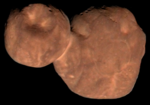| J043947.08+163415.7 | |
|---|---|
 QSO J0439+1635 (right) with a galaxy in the foreground (left) QSO J0439+1635 (right) with a galaxy in the foreground (left) | |
| Observation data (Epoch ) | |
| Constellation | Taurus |
| Right ascension | 04 39 47.10 |
| Declination | +16° 34′ 15.79″ |
| Redshift | 6.51 |
| Distance | 12.873 × 10 LY |
| Other designations | |
| 2MASS J04394708+1634160, UHS J043947.08+163415.7, WISEA J043947.09+163415.8 | |
| See also: Quasar, List of quasars | |

QSO J0439+1634, often referred to by just its coordinates, J0439+1634 or J043947.08+163415.7, is a superluminous quasar, and was, until 20 February 2024, (when it was superseded by QSO J0529-4351) considered the brightest quasar in the early universe with a redshift of z = 6.51. It is approximately 12.873 billion light-years away. The brightness of the quasar is equivalent to about 600 trillion luminosities of the Suns with gravitational lensing, without this effect 11 trillion. The quasar-related supermassive black hole has a mass of 700 million solar masses.
Discovery
On April 3, 2018, the ACS/WFC observed and photographed gravitational lensing at the location of the quasar, and further research revealed an extremely bright and large quasar there.
References
- ^ "J0439+1634". HubbleSite.org. Retrieved 2021-06-30.
- ^ Xiaohui Fan; Feige Wang; Jinyi Yang; Charles R. Keeton; Minghao Yue; Ann Zabludoff; Fuyan Bian; Marco Bonaglia; Iskren Y. Georgiev; Joseph F. Hennawi (January 9, 2019), "The Discovery of a Gravitationally Lensed Quasar at z = 6.51", The Astrophysical Journal Letters, 870 (2): L11, arXiv:1810.11924, Bibcode:2019ApJ...870L..11F, doi:10.3847/2041-8213/aaeffe
- ^ "NASA's Hubble Helps Astronomers Uncover the Brightest Quasar in the Early Universe". HubbleSite.org. Retrieved 2021-06-21.
- ^ "QSO J0439+1634". SIMBAD. Centre de données astronomiques de Strasbourg. Retrieved 19 March 2024.
- ^ information@eso.org. "Hubble sees the brightest quasar in the early Universe". www.spacetelescope.org. Archived from the original on 2019-01-10. Retrieved 2021-06-21.
- ^ Karl Hille (2019-01-08). "Hubble Helps Uncover the Brightest Quasar in the Early Universe". NASA. Archived from the original on 2021-05-13. Retrieved 2021-06-21.
- ^ "Астрономы нашли самый яркий квазар ранней Вселенной" [Astronomers have found the brightest quasar of the early Universe]. Журнал The Universemagazine Space Tech (in Russian). 2019-01-16. Archived from the original on 2021-06-24. Retrieved 2021-06-21.
- "Обнаружен самый яркий квазар юной Вселенной, который поможет раскрыть тайны эпохи реионизации" [The brightest quasar of the young universe has been discovered, which will help to reveal the secrets of the reionization era.]. in-space.ru (in Russian). 2019-01-10. Archived from the original on 2021-06-24. Retrieved 2021-06-21.
Further reading
- "Astronomers Uncover the Brightest Lensed Quasar in the Early Universe – W. M. Keck Observatory". 9 January 2019. Archived from the original on 2021-06-24. Retrieved 2021-06-21.
- Mara Johnson-Groh 09 January 2019 (9 January 2019). "Ultrabright Quasar Lit Up the Early Universe". livescience.com. Archived from the original on 2021-06-24. Retrieved 2021-06-21.
{{cite web}}: CS1 maint: numeric names: authors list (link) - "Гравитационное линзирование: квазар J043947.08+163415.7" [Gravitational lensing: Quasar J043947.08+163415.7] (in Russian). VideoNews. 2019-03-24. Archived from the original on 2021-06-24. Retrieved 2021-06-21.





